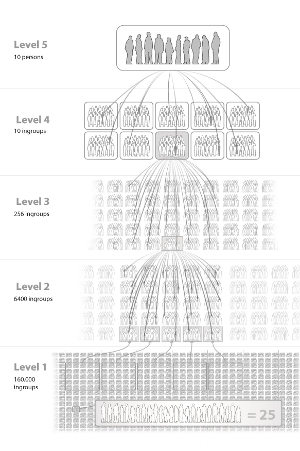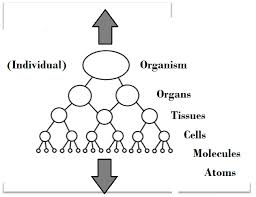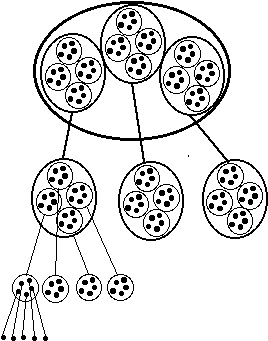 |
| A model of the ultimate representative democracy, adjusted for Norway. Larger nations will need one more level of ingroups. |
Original article here.
Nesting Instinct
Governance activities are organized in multiple layers of nested enterprises.
— Elinor Ostrom
It was Elinor Ostrom who began to speak of nestedness as one of the key components of a successful co-governance of the commons. But tribal societies had long been organized along these lines. A regional tribal alliance nested within it several tribes, which each nested several bands, and those nested several affinity clusters, composed of individual human beings. This way of organizing has an organic feel to it; our own bodies are “nested enterprises.”
Why don’t we learn from the growth of entities that are not known for ravaging the inheritance they have been given? A healthy cell does not grow unchecked. It divides. The divided cells form clusters, which form tissues, which form organs, and eventually, an organism arises, all without anyone dictating the development. That is how nestedness works. Some call it holarchy. They say it’s a type of hierarchy, but it seems to me the inverse of a hierarchy: there is no top or bottom, and there are no bosses. As this diagram shows, there are always more potential levels each way, as atoms give way to subatomic particles, and organisms rise together to form societies, ecosystems, and beyond.
Holarchy: a meta-system of irreducible wholes that are themselves part of larger wholes, ultimately comprising all life on earth from a single cell to the entire planetary ecosphere.What if we were to grow communities via natural self-organization? Individuals spontaneously form affinity groups. Some flourish more than others, and divide. Out of several, a band emerges. Out of a few bands, a tribe emerges. (It would take only 7 layers starting with groups of a dozen to include every human on the face of the earth!) Note that this sort of growth does not do violence to the prior, more local, smaller groupings. They keep on flourishing, part and parcel of the logic of that particular social organism.
What is the advantage of this way of growth and organization, besides imitating the success of Mother Nature? Governance can take place appropriately; the smaller, earlier units largely retain their autonomy; the broader, more encompassing later units like bands and tribes deal with broader matters that pertain to bands and tribes. Easy conversations, intimacy and trust are undiminished. At the same time, the larger, later units bring with their emergence novel advantages: coordination, attention to larger parts of the commons, diversified talent pools, and clout. And the organization that remains anchored in small groups of trusted associates has a leg up on the problem of free riding. It is easy to see what other people are doing within your group; easy to apply peer pressure if needed. The genius of successful commons management summarized in Ostrom’s eight principles rests on trust which is impossible without people knowing one another well over time.
Nested systems are self-organizing, emergent, bottom-up systems. They preserve direct involvement of each member. They are polycentric, having many semi-autonomous decision nodes rather than one. This makes them robust, adaptable, and resilient. Rules too are crafted from the bottom up, and are adjustable by the members with a focus on creating a structure of incentives favorable to both trust-building and maintaining a diverse environment favorable to discovering better solutions to problems. To paraphrase Ostrom, “when large systems fail, there are smaller systems to call upon — and vice versa.” Each smaller, earlier level is influenced by, and itself influences, the broader, later levels. Each cluster, each band, each tribe is an entity unto itself, and a part of an entity larger than itself. Allowing decisions to be made as close to the scene of events and the actors involved as possible, each affinity cluster, each band is a self-regulating, open system that displays both the autonomous properties of wholes and the dependent properties of parts.
So. What’s stopping us?








No comments:
Post a Comment
Note: Only a member of this blog may post a comment.